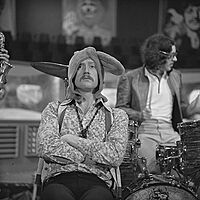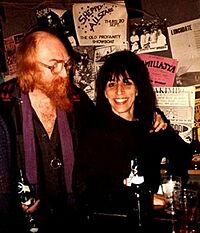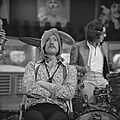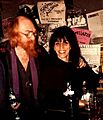Vivian Stanshall facts for kids
Quick facts for kids
Vivian Stanshall
|
|
|---|---|

Stanshall with his bulldog Bones on a towpath in Shepperton, England, 1980
|
|
| Background information | |
| Birth name | Victor Anthony Stanshall |
| Also known as | Viv Stanshall |
| Born | 21 March 1943 Shillingford, Oxfordshire, England |
| Died | 5 March 1995 (aged 51) Muswell Hill, London, England |
| Genres | Rock and roll, satire, spoken word, comedy rock, psychedelic pop, trad jazz, avant-garde |
| Occupation(s) |
|
| Instruments | Vocals, trumpet, trombone, guitar, keyboards, percussion, flute, recorder, ukulele, mandolin, banjo, harp, harmonica, kazoo |
| Years active | 1965–1995 |
| Labels | Warner Bros., Liberty, Charisma, Polydor |
Vivian Stanshall (born Victor Anthony Stanshall; 21 March 1943 – 5 March 1995) was an English singer, songwriter, and musician. He was also an author, poet, and a very witty person. He is best known for his work with the Bonzo Dog Doo-Dah Band. He also created Sir Henry at Rawlinson End, which was a radio series and later a film. Vivian was also the Master of Ceremonies on Mike Oldfield's famous album Tubular Bells.
Contents
Growing Up and Learning
Vivian Stanshall was born on 21 March 1943 in Shillingford, Oxfordshire. His birth name was Victor Anthony. His father was in the RAF during Second World War. Vivian lived with his mother during this time. He said these early years were the happiest part of his childhood.
When the war ended, his father came home. Young Victor found his father quite strict. His father made him speak with a special "posh" accent. This accent later became a part of Vivian's unique style. His family moved to Walthamstow, Essex. His younger brother, Mark, was born there in 1949.
Vivian studied at Walthamstow College of Art. There he met other creative students like Ian Dury. When he was 10, his family moved to Leigh-on-Sea. He went to Southend High School for Boys until 1959. As a young man, Vivian worked odd jobs at the Kursaal fun fair in Southend-on-Sea. He called bingo and painted fairground rides. To save money for art school, he worked for a year in the Merchant Navy. He said he was not a good waiter, but he became great at telling amazing stories.
Vivian then went to the Central School of Art and Design in London. He joined other students to form a band. This group included Rodney Slater and Neil Innes. Neil Innes remembered Vivian wearing funny clothes and carrying a euphonium. Around this time, Victor changed his first name to 'Vivian'. This became his legal name in 1977.
The Bonzo Dog Band Years
The Bonzo Dog Doo-Dah Band got its name from a word game Vivian played. They cut up sentences and put them back together. 'Bonzo Dog/Dada' was one idea they liked. They later shortened the name to The Bonzo Dog Band, or just The Bonzos.
The band often played funny versions of songs from the 1920s and 1930s. They found these old songs on 78 records bought cheaply at flea markets. For a while, the band played in pubs and colleges. They later became full-time musicians. They often traveled to small gigs in an old van. It was packed with instruments and props.
In 1967, they appeared in the Beatles' TV film Magical Mystery Tour. They played Vivian's song "Death Cab for Cutie". This led to them becoming the house band on Do Not Adjust Your Set. This was a children's TV show. It also featured early appearances by members of what became Monty Python.
In 1968, The Bonzos had a big hit song called "I'm the Urban Spaceman". Paul McCartney helped produce it. The band toured a lot and recorded many songs for the BBC. They also went on two tours in the United States. During their second tour, the Bonzos decided to break up. This was partly because Vivian was getting nervous about performing. They played their last show in March 1970.
After the Bonzos
After the Bonzos, Vivian formed several new groups. These included biG GRunt and The Sean Head Showband. In 1970, biG GRunt recorded a session for BBC Radio 1's John Peel. They also appeared on BBC television. However, biG GRunt broke up during their first UK tour.
Vivian soon recorded his first solo song, "Labio-Dental Fricative". It featured Eric Clapton on guitar. Later that year, he released "Suspicion". This song featured Keith Moon and John Entwistle from the Who.
In 1971, Vivian worked again with Neil Innes and others as 'Freaks'. They toured with new songs. They were often called 'Bonzo Dog Freaks' to help sell tickets. Vivian also helped start a group called Grimms. It combined performance, poetry, and music.
Vivian continued to write, record, and tour. He was also a regular guest on many BBC radio shows. Vivian had many funny adventures with his friend Keith Moon. In one story, they went to a tailor's shop. They pretended to fight over a pair of trousers. They ripped them in half. Then, a one-legged actor they hired arrived. He said, "Just what I was looking for!" and bought the ripped trousers.
In 1971, Vivian hosted a BBC Radio One show called Vivian Stanshall's Radio Flashes. It was a mix of music and funny sketches. Keith Moon also appeared in these sketches.
Rawlinson End Stories
Vivian created his famous work, Rawlinson End, as a spoken word performance. He recorded an early version with The Bonzo Dog Band. Starting in 1975, he made it into a surreal radio series for BBC Radio 1. It told the strange and wonderful adventures of Sir Henry Rawlinson. Other characters included his wife Florrie and his "unusual" brother Hubert.
In 1978, Vivian released an album called Sir Henry at Rawlinson End. This album used some of the radio material. It was then made into a film version in 1980. The film was in sepia-tinted black-and-white. Trevor Howard played Sir Henry, and Vivian played Hubert. A book of the same title was also published in 1980.
A second Rawlinson album, Sir Henry at N'didi’s Kraal (1984), told the story of Sir Henry's trip to Africa. At that time, Vivian lived on The Searchlight, a houseboat on the River Thames. He recorded the second 'Sir Henry' album there. The BBC radio shows continued until 1991. In the same year, Vivian went on a concert tour called 'Rawlinson Dog Ends'. It featured new Rawlinson End stories.
Vivian started recording a new Rawlinson End album. However, this work stopped when he passed away in March 1995.
The 1970s and Beyond
Vivian often performed live with Grimms. He also worked with other groups. He was a frequent guest on BBC radio shows like Start The Week.
In 1973, Vivian recorded songs for the movie soundtrack That'll Be the Day. He also appeared as the Master of Ceremonies on Mike Oldfield's album Tubular Bells. He also made guest appearances on other artists' recordings. These included John Entwistle's Smash Your Head Against The Wall.
In 1974, Vivian wrote and recorded his first solo album, Men Opening Umbrellas Ahead. This album was more serious than expected. Its lyrics explored his feelings with poetic images. The music had a "tribal" or "fusion" sound. It featured Nigerian musician Gasper Lawal. Many tracks had African percussion and singing. This album was an early example of mixing world music with rock music. Friends like Neil Innes and Steve Winwood also appeared on the album.
In 1975, Vivian narrated Peter and the Wolf. This album featured many famous musicians. In 1976, he released his song "The Young Ones". He sang it in the style of Boris Karloff.
In 1977, Vivian and his partner, Pamela 'Ki' Longfellow, moved onto a houseboat called The Searchlight. Vivian used this time to create Sir Henry at Rawlinson End. He also wrote the script for the film version.
The 1980s and Stinkfoot
After 'Sir Henry', Vivian wrote songs for his album Teddy Boys Don't Knit (1981). He and Ki Longfellow married in 1980. Together, they wrote songs for a musical comedy called Stinkfoot, a Comic Opera.
In 1982, Vivian provided a spoken part for a song by The Damned. After The Searchlight sank, the Stanshalls lived on The Thekla. This was a large boat that Ki had bought. She sailed it to Bristol Docks and turned it into a floating theatre. Vivian joined her there in 1983.
In December 1985, their musical Stinkfoot, A Comic Opera opened. Vivian wrote 27 songs for it. The show has been popular and was performed again in London and Bristol.
Family Life
In 1968, Vivian married Monica Peiser, an art student. Their son, Rupert, was born that year. They divorced in 1975.
On 9 September 1980, Vivian married Pamela 'Ki' Longfellow. Ki had a daughter from a previous relationship. Vivian and Ki had a daughter, Silky, born in 1979, before they married. Vivian celebrated Silky's birth and his marriage to Ki in songs on his album Teddy Boys Don't Knit. Vivian and Ki lived apart from 1986 until his death in 1995.
Years later, Ki Longfellow wrote a book about Vivian's life and work. It was called The Illustrated Vivian Stanshall: A Fairytale of Grimm Art.
Remembering Vivian
In 1991, Vivian made a short film about his early life called Vivian Stanshall: The Early Years. He said he was scared of his father, who he felt never approved of him. His last TV appearance was on 27 November that year.
A radio show in 1994, Vivian Stanshall: Essex Teenager to Renaissance Man, included an interview with his mother. She said his father loved him. Vivian said his father never showed it.
His Passing
Vivian Stanshall was found passed away on the morning of 6 March 1995. He was in his flat in Muswell Hill, north London. His funeral was held at the Golders Green Crematorium. A few days later, a memorial service was held for him.
A special plaque was put up in Poets' Corner at Golders Green Crematorium in 2015. It is near the plaque for his friend Keith Moon. His wife Ki and daughter Silky were there. Many fans and friends helped pay for the plaque.
His Impact and Tributes
After Vivian's passing, writer Chris Welch said Vivian was a "wild eccentric" and a strong person. He was charming but also could be very powerful. Neil Innes called him "a national treasure".
In 2001, a biography called Ginger Geezer: The Life of Vivian Stanshall was written. That same year, Jeremy Pascall and Stephen Fry made a radio documentary about Vivian for BBC Radio 4. It included many clips from Vivian's work.
In 2003, the script for Stinkfoot: An English Comic Opera was published. It had an introduction by his wife, Ki. In 2009, BBC Radio 4's Great Lives featured a program on Vivian. Neil Innes nominated him, and Ki Longfellow was a guest expert.
In 2010, the Sir Henry at Rawlinson End album was turned into a one-man show. Michael Livesley played all the characters. The show was very popular. In 2013, to celebrate Vivian's 70th birthday, Michael Livesley performed the show again. Many former Bonzos members joined him.
In 2011, the Blackpool Comedy Carpet was unveiled. This large public artwork in Blackpool honors over 1000 famous comedians. Vivian Stanshall is included with two quotes and his name.
In 2012, Vivian's album Men Opening Umbrellas Ahead was reissued. It included new notes from his wife and daughter. In 2018, Ki Longfellow's detailed book about Vivian's life was published. It included his paintings, sketches, and private photos.
In July 2023, two albums by Vivian were released after his passing. Dog Howl in Tune was a rock album he had planned. Rawlinson's End used tapes from Vivian's old recordings.
Vivian Stanshall's Music
Songs (Singles)
- "Labio Dental Fricative" (1970)
- "Suspicion" (1970)
- "Lakonga" (1974)
- "The Young Ones" (1976)
- "Terry Keeps His Clips On" (1980)
- "Calypso To Colapso" (1981)
- "Blind Date" (2016, a vinyl release of old recordings)
Albums
- Men Opening Umbrellas Ahead (1974)
- Sir Henry at Rawlinson End (1978)
- Teddy Boys Don't Knit (1981)
- Sir Henry at N'didi’s Kraal (1984)
- Dog Howl in Tune (2023, released after his passing)
- Rawlinson's End (2023, released after his passing)
Other Music Appearances
- That'll Be The Day (1973, soundtrack)
- Tubular Bells by Mike Oldfield (1973, as Master of Ceremony)
- "Dream Gerrard" from Traffic's album When the Eagle Flies (1974, Vivian wrote the lyrics)
- The Roughler Presents The Warwick Sessions Volume 1 (1987, one song)
- "The Last Temptation of Elvis" (1989, one song)
- The Famous Charisma Box (1993, nine songs)
- The Charisma Poser (1993, one song)
Images for kids









